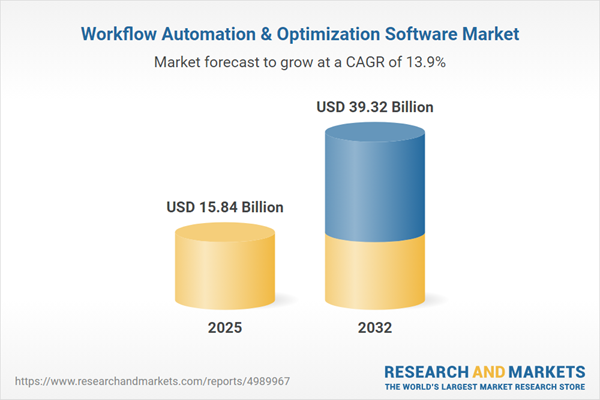Speak directly to the analyst to clarify any post sales queries you may have.
Workflow automation and optimization software is rapidly reshaping how enterprises streamline processes and improve strategic agility. Senior decision-makers are increasingly leveraging these platforms to accelerate digital transformation and create new avenues for operational excellence.
Market Snapshot: Workflow Automation & Optimization Software
The Workflow Automation & Optimization Software Market grew from USD 13.88 billion in 2024 to USD 15.84 billion in 2025. The market is projected to advance at a CAGR of 13.89%, achieving a value of USD 39.32 billion by 2032.
Scope & Segmentation
- Industry Verticals: Banking, Capital Markets, Insurance, Hospitals, Pharmaceuticals and Biotechnology, IT Services, Telecom Operators, Automotive, Electronics, Brick and Mortar, and Online Platforms.
- Deployment Modes: Cloud (including Hybrid Cloud, Private Cloud, and Public Cloud) and On-Premises.
- Solution Types: Business Process Management, Integration Platform, Low Code Development Platform.
- Workflow Types: Customer Onboarding (including Data Entry and Verification, KYC Verification), Document Management (Document Capture, Document Storage and Retrieval), HR Management (Payroll and Benefits, Recruitment), Invoice Processing (Purchase Invoice Automation, Sales Invoice Automation).
- Regions: Americas (including North America: United States, Canada, Mexico; Latin America: Brazil, Argentina, Chile, Colombia, Peru), Europe, Middle East & Africa (including United Kingdom, Germany, France, Russia, Italy, Spain, Netherlands, Sweden, Poland, Switzerland, United Arab Emirates, Saudi Arabia, Qatar, Turkey, Israel, South Africa, Nigeria, Egypt, Kenya), Asia-Pacific (including China, India, Japan, Australia, South Korea, Indonesia, Thailand, Malaysia, Singapore, Taiwan).
- Leading Companies: UiPath, Automation Anywhere, Microsoft, Blue Prism, Pegasystems, Appian, SAP, Oracle, IBM, Software AG.
Key Takeaways for Senior Decision-Makers
- Workflow automation and optimization software is now fundamental for organizations targeting both operational improvements and customer-centric strategies.
- The convergence of artificial intelligence, low code development, and seamless systems integration is generating enterprise-wide transformations.
- Vendors are evolving their platforms with analytics, prebuilt connectors, and stronger governance to address the complexities of distributed and regulated environments.
- Distinct verticals, such as BFSI and healthcare, are capitalizing on workflow orchestration and automation to manage compliance and accelerate mission-critical processes.
- Hybrid cloud solutions, combined with modular software architectures, are favored for balancing agility, scalability, and regulatory compliance requirements.
- Collaboration with cloud, integration, and consultancy partners helps organizations streamline implementation and maximize the performance of core workflow systems.
Tariff Impact on Workflow Automation and Enterprise Operations
The introduction of United States tariffs in 2025 has affected organizations depending on international supply chains and software sourcing. Companies are realigning deployment and procurement strategies, moving towards resilient models that favor asset portability and increased process automation to manage higher operational costs. Vendors are responding with adaptive licensing, local data hosting, and enhanced integration tools, enabling enterprises to mitigate tariff-related risks while sustaining service continuity.
Methodology & Data Sources
The findings are grounded in interviews with senior technology executives, complemented by comprehensive secondary research such as regulatory filings, vendor documentation, and academic literature. Analytical techniques, including statistical segmentation and real-world case assessments, underpin the validation of adoption trends and strategic recommendations.
Workflow Automation & Optimization Software: Why This Report Matters
- Provides reliable, actionable insights to support executive investment decisions, technology roadmaps, and partner assessments across fast-evolving technology domains.
- Equips teams with competitive intelligence on sector trends, policy shifts, and vendor positioning to enable strategic planning and sustained operational improvement.
Conclusion
Workflow automation and optimization software is essential for organizations seeking operational agility and long-term growth. By embracing a holistic, segmented, and region-specific approach, enterprises can unlock efficiencies and bolster their competitive position in a rapidly changing market.
Additional Product Information:
- Purchase of this report includes 1 year online access with quarterly updates.
- This report can be updated on request. Please contact our Customer Experience team using the Ask a Question widget on our website.
Table of Contents
3. Executive Summary
4. Market Overview
7. Cumulative Impact of Artificial Intelligence 2025
Companies Mentioned
The companies profiled in this Workflow Automation & Optimization Software market report include:- UiPath, Inc.
- Automation Anywhere, Inc.
- Microsoft Corporation
- Blue Prism Limited
- Pegasystems Inc.
- Appian Corporation
- SAP SE
- Oracle Corporation
- IBM Corporation
- Software AG
Table Information
| Report Attribute | Details |
|---|---|
| No. of Pages | 196 |
| Published | October 2025 |
| Forecast Period | 2025 - 2032 |
| Estimated Market Value ( USD | $ 15.84 Billion |
| Forecasted Market Value ( USD | $ 39.32 Billion |
| Compound Annual Growth Rate | 13.8% |
| Regions Covered | Global |
| No. of Companies Mentioned | 11 |









